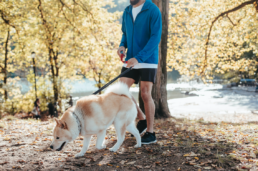By Sandra Huskey, First Mile Care DPP Coach
There is mounting research connecting sedentary lifestyles to an increased risk of diabetes, dementia, and heart disease as people age. Some experts have even referred to sitting as the new smoking — it has the potential to be that deadly!
According to the Centers for Disease Control and Prevention (CDC), more than one out of every three adults in the U.S. has prediabetes, and nearly half of adults have high blood pressure — conditions aggravated by long hours of physical inactivity. Luckily, simple movement and exercise can help mitigate the negative health effects associated with extended durations of sitting.
In the First Mile Care Diabetes Prevention Program (DPP), coaches advise participants to get at least 150 minutes of moderate-intensity physical activity each week. Coaches recommend you keep track of how much time you spend sitting still each day, for a few days, to have a baseline number for comparison. You will probably be surprised to find that even when you get 150 minutes of activity a week, you spend an awful lot of time sitting still — especially if you have a desk job.
Check out these tips if you’re trying to build habits to incorporate movement breaks.
1. Find a fitness activity you like. Try going for a walk outside, 5-minute yoga, or even a dance break (like this BeeGees one or this Elvis one). Be honest with yourself about your enjoyment level of the activity. You’ll find an excuse to stay sitting down if you’re trying to avoid the movement you have planned!
2. Break it up. Sometimes it’s easier to find small chunks of time throughout the day than one giant period of time. The DPP recommends two minutes of movement for every 30 minutes. Researchers at Columbia University Medical Center recently published a study in the journal Medicine & Science in Sports & Exercise that showed even a five-minute walk every half-hour can help control blood sugar and undo a lot of the risks incurred by sitting for long periods.
3. Create times to move. Taking a movement break might not come naturally in your busy life. You may need to set a timer to remind yourself to stand up and walk around every half-hour until it becomes a habit.
4. Invest in a treadmill or standing desk. On the days that inclement weather doesn’t allow an outside walk or life becomes too busy to disconnect, a treadmill can help maintain your habits. Some people have set up their desks around a treadmill to encourage walking while working and taking meetings. In that way, you don’t have to choose between productivity and your health. There are even space-saving under-desk treadmills and walking pads, too. If you must remain seated at a desk, try sitting on an exercise ball which allows some bouncing movement.
5. Take a stretching break. If the cold, heat, or humidity isn’t in your favor or you’re not feeling up to your usual movement, try taking a stretch break. Stretch breaks will help reduce muscle tension and increase blood circulation. Static muscles will fatigue easily and stretching will help you become comfortable (and make tasks less difficult)!
6. Multi-task. Too many items to cross off your to-do list? See if you can combine your errands with movement. For example, if you live within walking distance, step out on foot to the grocery store or post office. Hold standing or walking conference calls with co-workers, or make a rule that you’ll only allow yourself to phone a family member while you’re on your feet. Create a new habit of always walking in place during the opening credits of your favorite TV show, or during a comedian’s opening monologue. If you use public transportation, stand instead of grabbing a seat, at least for a few stops.
7. Make it engaging. Turn up the music or your favorite podcast during activities. You’re more likely to build and maintain a new habit if it’s coupled with something that you already look forward to doing, and listening to energizing music can help you move faster without realizing it. If you’re into video gaming, a virtual reality (VR) headset may get you on your feet and moving around as your mind is tricked into entering immersive simulated environments.
8. Build in a healthy reward. There’s no better way to encourage a habit than positive reinforcement when you achieve a goal. Maybe there’s a movie or TV show you’ve been wanting to watch or a special purchase you’ve put off. After incorporating movement breaks in your day, a reward is definitely earned!
Take the advice of Gloria Estefan — get on your feet! Get up, stand up, and take some action to promote healthy aging.
To learn more about how you can benefit from the First Mile Care Diabetes Prevention Program, take the prediabetes risk test and get started today!



